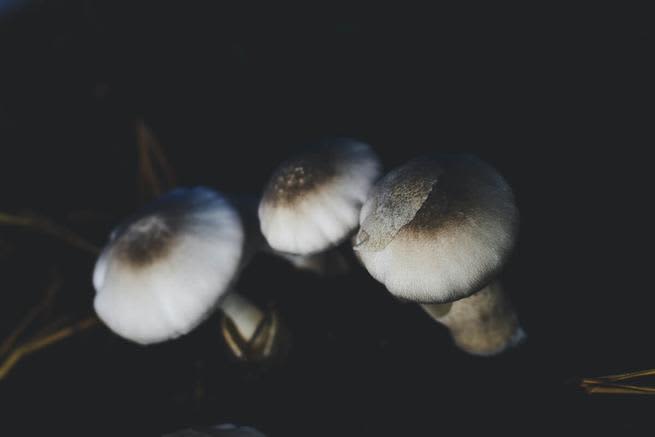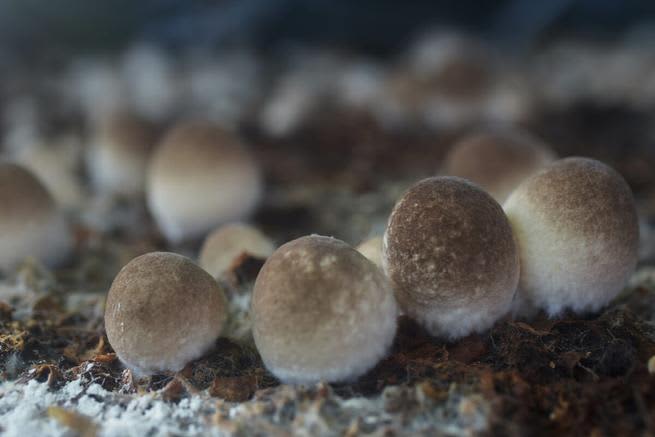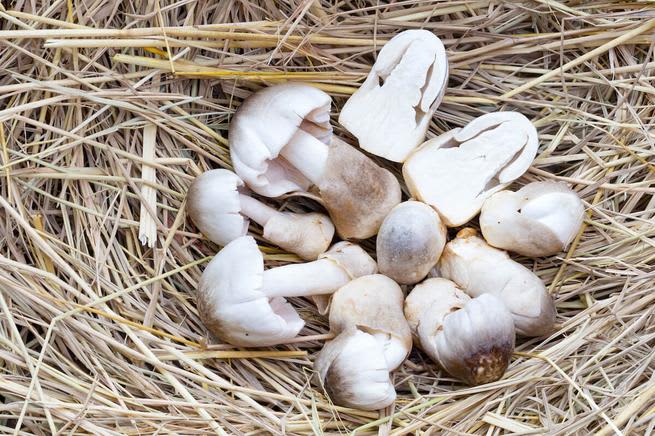

A known staple of Asian cuisine, paddy straw mushrooms are one of the most consumed fungi in the world. Their lax growth conditions and their ability to preserve well once dried have allowed them to expand to countries outside their native Southeast Asia.
But surprisingly, not many people know this species has nutritional and health values. From providing several minerals and vitamins to keeping your skin healthy, paddy straw mushrooms have proven to be much more than a simple edible fungus. Here’s what you need to know.
What are paddy straw mushrooms?
Paddy straw mushrooms, scientifically known as Volvariella volvacea, are a species of edible mushrooms widely used in Asian cuisine. Although their flavor is less intense and complex than other fungi, paddy straw mushrooms have gained popularity as one of the easiest species to cultivate and preserve.
You’ll usually find V. volvacea in a few forms: unpeeled, peeled, canned, and dried. The latter two are very common in Asian markets—however, unpeeled and peeled mushrooms may be more nutritious and flavorful. Unpeeled (or button stage) refers to specimens that have yet to show their cap, while peeled mushrooms are already mature (1).
Paddy straw mushrooms are native to Southeast Asia. However, their lax growth conditions and fruitful yields have allowed them to expand to the rest of the world. They’re particularly common in the southern areas of eastern North America.
While the flavor and aroma may not be as universally acclaimed as that of some other fungi, paddy straw mushrooms are still considered a choice edible by some experts. For example, renowned mycologist Paul Stamets describes the taste of fresh V. volvacea as explosive and full—although he does remark that canned specimens don’t taste nearly as good (2).
How does Volvariella volvacea look?
Paddy straw mushrooms show a conic 5–12 cm (2–4.7 in) cap that becomes broadly convex as the mushrooms ages. The color is gray to brownish gray, often showing silky hairs that streak from the very center of the top of the cap.
The stem or stipe is 6–12 cm (2.3–4.7 in) long and often shows a distinctive volva at the base. The volva is the remains of the universal veil from where the cap hatches—you can think of it as a sort of eggshell. It has a brownish-pink spore print with the gills sharing that same color (3).
What are the varieties of paddy straw mushrooms?

No known varieties, strains, or subspecies of paddy straw mushrooms exist. Previously, however, some mycologists had classified five different varieties:
- Volvariella volvacea var. heimii
- Volvariella volvacea var. lignicola
- Volvariella volvacea var. masseei
- Volvariella volvacea var. nigricans
- Volvariella volvacea var. volvacea
Modern mycology considers these varieties basionyms—earlier classifications now obsolete. This means they don’t have any significant differences with the type V. volvacea. As such, if you come across any of these varieties online or in a field guide, remember that they’re all the same thing. (4)
History of paddy straw mushrooms

Not much is known about the specific history of paddy straw mushrooms. But we do know that they are one of the most prevalent fungi in Asia and that traditional cultures there have been eating mushrooms for thousands of years.
The first written record of edible mushrooms in Asia is The Book of Songs, a Chinese work from the third century A.D., that mentions about 200 plant and mushroom species. Almost a thousand years later, the first book devoted exclusively to fungi (The Mycoflora) appears. Yet, there’s still no specific mention of paddy straw mushrooms there (5).
Some experts point out that, although the earliest records of cultivation date back to the 18th century, Buddhist monks grew the species for much longer than that. For example, monks in the Nanhua Temple in China cultivated the species for its nutritional and medicinal benefits. Unfortunately, there aren’t any detailed records documenting this (6).
The first official mention of V. volvacea appeared in Paris, when Pierre Bulliard described the species under the name Agaricus volvaceus. Rolf Singer later corrected the definition in 1951, transferring it to the Volvariella genus (4).
There’s no doubt that Asian cultures have been using paddy straw mushrooms for a long, long time. But we may never know just how old the relationship between the species and humans actually is—but it’s safe to say that it’s at least a couple thousand years old.
Health benefits of paddy straw mushrooms

Paddy straw mushrooms could be considered functional fungi—species with significant health and nutritional values. However, research on the species is few and far between, and the health benefits are not as substantial as that of other fungi.
Nutritionally, however, paddy straw mushrooms provide a fantastic balance regarding both macronutrients and micronutrients. A serving of V. volvacea comprises 26–30% protein, 45–50% carbohydrates, 9–12% fiber, and 9–13%. As you may have noticed, the mushroom contains little to no fat.
Furthermore, the species provides vitamins A, C, and B, along with some assorted amino acids and minerals (calcium, sodium, and iron). As for its energetic value, a 100-gram serving of dried mushrooms only contains about 285 kcals (2) (7).
The main health benefit of paddy straw mushrooms is related to skin care. A 2022 study shows that V. volvacea could be a good source of specific polysaccharides with moisturizing and anti-wrinkle properties. Similarly, they could improve skin elasticity and firmness (8).
Recent research also indicates that paddy straw mushrooms could boost the immune system. While research is scarce, early trials found that certain compounds in the species could facilitate the response of T cells—a type of white blood cell that fights germs and diseases (9).
Are there any side effects to eating Volvariella volvacea?
Eating paddy straw mushrooms has some very uncommon side effects. The species has a small chance of causing fungal infection in immunocompromised patients, which could lead to severe consequences such as brain abscesses (10).
However, it’s crucial to remember that the odds of this happening are slim—if you’re eating cooked V. volvacea and aren’t immunocompromised, there’s nothing to worry about. But, as always, check with a doctor if you’re having doubts!
Where do paddy straw mushrooms grow?

Paddy straw mushrooms are widespread throughout tropical and subtropical Asia, and somewhat common in eastern North America. While it’s possible to find them in other parts of the world as well, reports are few and far between.
The species feeds on decaying or dead organic matter, so its preferred spawning substrates range from compost heaps to leaf piles. It seems particularly fond of rice straw (or horse straw) and cotton waste, so make sure you look near plantations and stables while you’re out harvesting.
Any season except winter is great for harvesting paddy straw mushrooms. The fruiting bodies tend to appear whenever there are periods of warm weather. Also, remember that patches of V. volvacea are often recurring—meaning that fungi will keep growing there if you give them enough time (2).
What is ethical wildcrafting?
Ethical wildcrafting refers to a series of guidelines designed to help you harvest natural resources without damaging the environment. Wildcrafting is often confused with foraging—the difference is that the former refers to harvesting for medicinal purposes and the latter for eating.
Unfortunately, many newcomers to the fungi world are unaware of the ecological damage caused by harvesting resources carelessly. But don’t worry. Practicing ethical wildcrafting is as simple as following these guidelines:
- Do your research before heading out. Try to note any possible endangered or poisonous lookalikes you may encounter in the field.
- Get your hands on a field guide. These practical manuals will go a long way in helping you find your desired species and teach you more about the local ecosystem.
- Don’t overharvest! Take only what you need, and don’t share patch locations with friends and family.
- Pick the mushrooms gently. Try to only use your hands and save scissors and knives for when absolutely necessary.
- Be aware of the legality of harvesting. Ask permission from the owner if you’re wildcrafting on private land or check local regulations if on public land.
If you’re new to mushroom hunting, we recommend you look for harvesting groups in your area. Veteran mycologists will be more than glad to help you find and identify your desired species.
Is it safe to wildcraft for Volvariella volvacea?
Eating wild-picked mushrooms is never 100% safe, as there’s always the risk of coming across a non-edible or even toxic lookalike. In the case of V. volvacea specifically, it’s hard to tell apart from Amanita phalloides (the death cap mushroom).
The death cap is not to be messed around; eating a single fruiting body could lead to death. It looks almost the same as V. volvacea, with the exception that it has a white spore print instead of a brownish-pink one. As such, make sure you only eat wild mushrooms under the close supervision of a professional.
How do you take paddy straw mushrooms?

Paddy straw mushrooms are relatively versatile mushrooms. You can cook them in almost any way you imagine, from baking to simmering. As such, try to incorporate them in any recipe that calls for mushrooms. Stews, soups, stir-fries, and even risotto are perfect for incorporating V. volvacea.
As always, don’t be afraid to experiment with other fungi. Shiitake, button, or wine cap mushrooms may just be the perfect companions to paddy straw fungi. However, if you’re new to cooking with mushrooms, below are two easy recipes to get started.
Paddy straw mushroom curry
To prepare a delicious paddy straw curry, wash and cut the mushrooms and put them in a bowl with water, turmeric powder, and salt. After 10 minutes, strain the mushrooms and saute them in a pan with oil for about 3–4 minutes. Add spices, herbs, chopped onion, chili, garlic, and any other ingredient you like. Finally, add some chopped tomatoes and potatoes and cook until it reaches the desired consistency.
Stir-fried straw mushrooms
Wash and cut the mushrooms while you heat some oil and butter on a non-stick pan. Add the mushrooms and stir fry until they release some water. Throw in chopped spring onions, soy sauce, and oyster sauce, and keep stirring. Once the onions have wilted, the stir-fried straw mushrooms are ready to be served.
Paddy straw mushroom: A wonderful Asian delight
The paddy straw mushroom (Volvariella volvacea) is a staple of Asian cuisine, with a long history of use that dates back at least a thousand years. Not only is it tasty but it also has some beneficial health properties for the skin. To learn more about other functional fungi and the latest news about psychedelic shrooms, be sure to keep up on shroomer.
References
- Mycological Society of San Francisco. “Volvariella volvacea.” (Last accessed September 12, 2023). https://www.mssf.org/cookbook/straw.html
- Paul Stamets, “The Paddy Straw Mushroom of the Genus Volvariella” in Growing Gourmet and Medicinal Mushrooms (1993), 343–350.
- Michael Kuo. “Volvariella volvacea.” MushroomExpert.com (2018). https://www.mushroomexpert.com/volvariella_volvacea.html
- Mycobank. “Volvariella volvacea.” (Last accessed September 12, 2023). https://www.mycobank.org/page/Name%20details%20page/29114
- Adrian Morgan. Toads and Toadstools: The Natural History, Folklore, and Cultural Oddities of a Strange Association (1995): 152–156.
- Specialty Produce. “Straw Mushrooms.” (Last accessed September 12, 2023). https://www.specialtyproduce.com/produce/straw_mushrooms_18494.php
- FoodData Central. “Paddy Straw Dried Mushrooms.” (2017). https://fdc.nal.usda.gov/fdc-app.html#/food-details/2114126/nutrients
- Sarita Sangthong, Punyawatt Pintathong, Patcharee Pongsua, Areeya Jirarat, Phanuphong Chaiwut. “Polysaccharides from Volvariella volvacea Mushroom: Extraction, Biological Activities and Cosmetic Efficacy.” Journal of Fungi 8(6) (2022): 572. https://doi.org/10.3390%2Fjof8060572
- Ju-Pi Li, Yi-Pang Lee, Jung-Chein Ma, Betty-Revon Liu, Nien-Tsu Hsieh, Dz-Chi Chen, Ching-Liang Chu, Ren-In You. “The Enhancing Effect of Fungal Immunomodulatory Protein-Volvariella Volvacea (FIP-vvo) on Maturation and Function of Mouse Dendritic Cells.” Life 11(6) (2021): 471. https://doi.org/10.3390%2Flife11060471
- Rawan Alagha, Sai Meng Tham, Kean Lee Chew, Janet Weng Sze Cheng, Derrick WenQuan Lian, Anantharaman Vathsala, Lionel Hon Wai Lum. “Volvariella volvacea brain Abscess in an immunocompromised host-An emerging fungal pathogen in Asia.” Journal de Mycologie Medicale 32(3) (2022). https://doi.org/10.1016/j.mycmed.2022.101272


